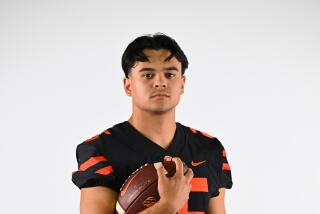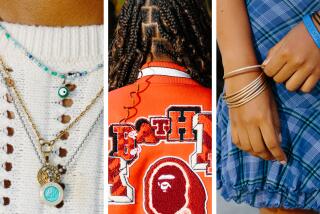Japanese Students Sample Life at U.S. Schools : Education: The visit to Junipero Serra High School was a cultural awakening for guests and hosts alike.
Naoko Ohshimaâs only images of the United States came from what she had read or the movies she had seen.
But there is no substitute for the real thing, and Thursday the 17-year-old from Oki Gakuen High School in Fukuoka, Japan, witnessed a day in the lives of American students at Junipero Serra High School in Gardena.
Ohshima was among 40 students who visited the school under a cultural awareness program sponsored by the Los Angeles Archdioceseâs Department of Catholic Schools. In all, 450 students from Ohshimaâs high school are touring 18 Catholic high schools in the Los Angeles area.
Neither Ohshima nor her classmates speak much English. They communicated through a translator and by using universal gestures and smiles.
The Junipero Serra student council greeted its guests with a continental breakfast in the school cafeteria, followed by a tour of classrooms and the school grounds.
Dressed in identical crisp white cotton shirts, forest green ties (on both the male and female students), black-and-white plaid skirts or pants and vests, and topped with navy blue blazers, the Japanese students were escorted by their American counterparts on a tour of the computer lab, library, and the biology, chemistry and physics labs. The group then assembled on the football field for a demonstration of a physics experiment--a model rocket blastoff.
No nook, cranny--or locker room--was left unvisited.
Gina Zanone, an officer with the Gardena Police Department, even stopped by to show the students the newest addition to the cityâs fleet of patrol cars.
âJapanese police cars do not have shotguns or computers,â said 17-year-old Daisuke Nakamura. âThat may be because there are more undercover officers than uniformed.â
Nakamura said he was more impressed with the size of the schoolâs baseball diamond.
Ohshima said she was worried about the American perception of the Japanese.
âI was afraid some Americans still thought of Japanese as wearing kimonos and samurai dress,â she said. Thankfully, she said, she was proved wrong.
What impressed her about Junipero Serra, Ohshima said, was the diversity of the school, with its mix of African-American, Latino and Anglo students. At home, she said, there are only three non-Japanese students among her schoolâs 2,000 students.
Jason Overs, a Serra senior, said he regretted not knowing Japanese so that he could communicate with the visitors.
âDo you have girlfriends?â he asked a small group of boys while gesturing to the girls.
After a few seconds of translation, the boys blushed and shook their heads âno.â
âYou donât?â Overs asked, a little surprised.
He then led his group to the school gym, where the students took turns shooting basketball before heading to the faculty garden for a barbecue steak lunch and entertainment.
After exchanging photos, addresses and gifts--Serra students presented their guests with school T-shirts and the Oki Gakuen students offered small puzzles and trinkets--the students exchanged hugs and hopes of meeting again.
âIf ever something needed to be done to bring Oriental students with black and Hispanic students, itâs this year . . . because of the divisions in Los Angeles society,â said Janice Eslami, dean of women and a religion teacher who arranged the visit.
Cornelio Busby, a 16-year-old sophomore, called the visit a âfascinating chance to interact with students from a different country.â
âThey seem very disciplined . . . you can tell by their uniforms,â he said.
More to Read
Sign up for Essential California
The most important California stories and recommendations in your inbox every morning.
You may occasionally receive promotional content from the Los Angeles Times.










